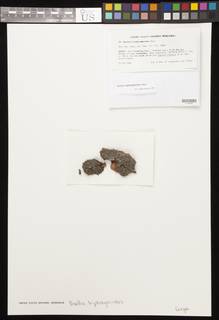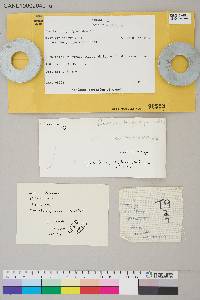
Consortium of Lichen Herbaria
- building a Global Consortium of Bryophytes and Lichens as keystones of cryptobiotic communities -
- Home
- Search
- Images
- Species Checklists
- US States: O-Z >
- US National Parks
- Central America
- South America
- US National Parks
- Southern Subpolar Region
|
Tetramelas triphragmioides (Anzi) A. Nordin & Tibell
 (redirected from: Buellia triphragmioides Anzi) (redirected from: Buellia triphragmioides Anzi) |
|
|
Family: Caliciaceae
[Buellia triphragmioides Anzi, moreMattickiolichen triphragmioides (Anzi) Tomas. & Cif.] |
Nash, T.H., Ryan, B.D., Gries, C., Bungartz, F., (eds.) 2007. Lichen Flora of the Greater Sonoran Desert Region. Vol 3. Thallus: crustose, continuous to areolate, flat to verrucose; prothallus: not seen surface: pale yellow, smooth, esorediate medulla: white, lacking calcium oxalate (H2SO4-) Apothecia: lecideine, abundant, discrete, seldom aggregated and confluent, 0.2-0.9 mm in diam., sessile disc: black, sometimes pruinose, with thin, yellowish white pruina consisting of xanthone crystals, flat to convex margin: first prominent, later excluded, enclosing disc in young apothecia proper exciple: 50-60 µm thick, lacking secondary metabolites; differentiated into a broad, dark brown outer part with carbonized cells (<6 µm, HNO3-), and a pale inner part, transient with the brown, <150µm thick hypothecium (HNO3-) epihymenium: brown, pigmentation continuous with the outer exciple (HNO3-) hymenium: hyaline, not inspersed with oil droplets, 60-70 µm tall; tips of paraphyses: ±7 µm wide with distinct apical caps asci: clavate, Bacidia-type, 50-65 x 17-24 µm, 8-spored ascospores: soon brown, 3-septate, ellipsoid, sometimes curved, (19-) 20.8-[22.7]-24.6(-27.5) x (7.5-)8-[8.7]-9.4 (-10.5) µm, walls and septa lacking uneven thickenings, proper wall c. 0.6 µm thick, perispore c. 0.25 µm thick, ornamentation: rugulate Pycnidia: rare, immersed, with uppermost part protruding, wall mainly pigmented in upper part conidia: bacilliform, 5-7 x 1 µm Spot tests: thallus K-, C+ orange, P-; medulla K-, C-, P- fluorescence: UV+ orange iodine reaction: medulla non-amyloid Secondary metabolites: arthothelin and some additional minor xanthones (Leuckert and Mathey 1975). Substrate and ecology: on bark and wood of broad-leaved and coniferous trees, often in subalpine forests World distribution: Europe, North America, Siberia and the Himalayas Sonoran distribution: Arizona (Mt. Baldy Wilderness, Apache Co.) and southern California (San Gabriel Wilderness, Los Angeles Co). Notes: Buellia triphragmioides is characterized by its yellowish thallus and its 3-septate spores. The species is similar to Buellia cedricola on the basis of its yellowish thallus, but differs by having 3-septate spores and a different secondary chemistry (see B. cedricola). Another similar species, B. vernicoma, occurring in eastern North America, has a more granulose thallus and smaller spores. |
Powered by Symbiota






















